Research Overview
Topics and Questions of Recent Research Interest
Research topics pursued in recent years by Earle Williams and his collaborators are summarized here. In most cases, the topics are introduced with a motivating question to focus the attention. Simple illustrations and a few references are included in each research category.
(1) Are Global Lightning Activity and the Global Electrical Circuit Responsive to Global Temperature Change?
The question just posed has intuitive support. Lightning is decidedly more prevalent in the hot afternoon than in the cooler night. Lightning is more prevalent in the hotter summer than the cooler winter. Lightning is more prevalent over land during the warm El Nino phase than during the cooler La Nina phase. But these observations still leave our question unanswered.
The global circuit provides a natural global integral of electrified weather. On a number of time scales, both the DC global circuit and the Earth's Schumann resonances show positive correlation with global temperature (Williams, 1992; 1994; 1999; 2004). Questions remain about the most important long time scale associated with global warming in the present epoch. The questions persist on the conceptual side because the convective adjustment of the global atmosphere is not well prescribed, and modest temperature differences (i.e, 1oC) have major effects. The questions persist on the observational side because the quantitative records on the global circuit are at most a few decades long and the natural variance is large.
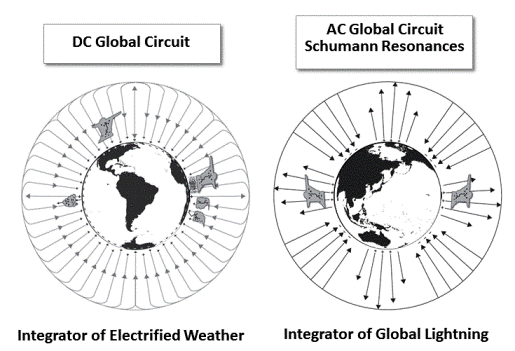
An inversion approach now under development for measuring the global lightning activity from multiple station ELF measurements of the background Schumann resonance. The detailed procedure is described in the documents available at the following links:
Click here to download the text materials
Click here to download the figures
In addition to the on-going multi-station inversion work, the long term (nearly twenty years) variation of Schumann Resonance (SR) modal parameters is being studied. The well calibrated preamplifiers installed at the induction coils operating underground, have been running for the entire duration and the record is the longest available SR magnetics till to date at any fixed location in the entire planet. Along with the magnetics, vertical ELF electric fields at different SR bands are also measured. The pronounced annual variation in global lightning activity, with maximum in Northern Hemisphere summer, is readily apparent in this record. The long term intensity variation appears to be statistically flat over the two decades as shown in the following figure. However, to properly interpret the variation with respect to the global temperature, local ionospheric height correction over solar cycles is required.
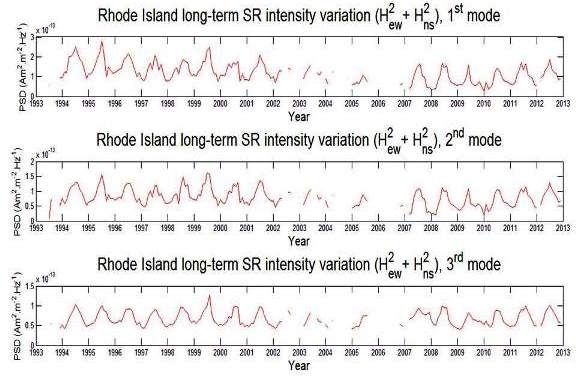
References
Markson, R., The global circuit intensity: Its measurement and variation over the last 50 years, Bull. Am. Met. Soc., DOI:10.1175/BAMS-88-2-223, 223-241, 2007.
Price, C. Global surface temperature and the atmospheric electric circuit, Geophys. Res. Lett., 20, 1363-1366, 1993.
Williams, E.R., The Schumann resonance: A global tropical thermometer, Science, 256, 1184-1187, 1992.
Williams, E.R., Global circuit response to seasonal variations in global surface air temperature, Mon. Wea. Rev.,122, 1917-1929, 1994.
Williams, E.R., Global circuit response to temperature on distinct time scales: A status report, in Atmospheric and Ionospheric Phenomena Associated with Earthquakes, Ed., M. Hayakawa), Terra Scientific Publishing (Tokyo), 1999.
Williams, E.R., Does global lightning activity provide a global thermometer, and if so, what thermometer? Workshop presentation, Lightning Monitoring from Space, Los Alamos National Laboratory, Santa Fe, New Mexico, September 27-28, 2004.
(2) Why is Lightning Activity so Strongly Concentrated over Land?
The order-of-magnitude contrast in lightning activity between land and ocean is generally attributed to the contrast in physical properties of the respective surface, but achieving a quantitative explanation has taken some time. The ocean surface is both mobile and characterized by a higher heat capacity than land, making it less susceptible to heating by sunlight. The boundary layer over land, in contrast, is heated to higher temperature and destabilized by solar radiation. A modest difference in cumulonimbus updraft speeds between land and ocean can account for large differences in lightning activity because the process of charge separation is so sensitive to updraft speed. Still, the land-ocean contrast in instability as measured by Convective Available Potential Energy (CAPE) has been shown (Williams and Stanfill, 2002) an insufficient explanation for the contrast in updraft strengths in land and ocean convection. A role for cloud base height (higher over land than over ocean) has been invoked to account for the updraft contrast (Williams and Stanfill, 2002).
An alternative explanation for the land-ocean lightning contrast is embodied in the aerosol hypothesis (Williams et al, 2002; Rosenfeld and Woodley, 2003). The boundary layer over land is substantially more polluted than over the sea. Measurements of aerosol and lightning activity in the Amazon rainforest (Williams et al, 2002) indicated that the aerosol was not the primary cause for contrasts in lightning activity. Further tests to distinguish aerosol from thermodynamic origins of lightning activity have been carried out (Williams and Stanfill, 2002; Williams et al, 2004; Pontikis et al, 2004) by exploring the dependence of lightning parameters on island area. These tests also support a primary role for thermodynamics and a difference in surface properties as the explanation for the land-ocean lightning contrast.

References
Pontikis, C., E. Hicks and N. Michalon, Comment on "The physical origin of the land-ocean contrast in lightning activity" by E. Williams and S. Stanfill, C.R. Physique, 5, 2004.
Rosenfeld, D. and W.L. Woodley, Closing the 5-year circle: From cloud seeding to space and back to climate change through precipitation physics, Chapter 6 of "Cloud Systems, Hurricanes, and the Tropical Rainfall Measuring Mission (TRMM), ed., W-K. Tao and R. Adler, Meteorol. Monogr., 51, 59-80, 2003.
Williams, E. and S. Stanfill, The physical origin of the land-ocean contrast in lightning activity, Comptes Rendus-Physique, 3, 1277-1292, 2002.
Williams, E.R., and Coauthors, Contrasting convective regimes over the Amazon: Implications for cloud electrification, J. Geophys. Res., LBA Special Issue, 107, D20, 8082, doi:10.1029/2001JD000380, 2002.
Williams, E., T. Chan and D. Boccippio, Islands as miniature continents: Another look at the land-ocean lightning contrast, J. Geophys. Res., 109, D16206, doi:10.1029/2003JD003833, 2004.
(3) Are Lightning-Producing Volcanic Eruptions just Dirty Thunderstorms?
Explosive volcanic eruptions are known to be strongly electrified (McNutt and Davis, 2000). The conventional thinking for the origin of this electrification involves the collisions of silicate minerals in the eruption column and the selective transfer of one of sign of charge to larger, faster-falling particles.
We are exploring an alternative idea (Williams and McNutt, 2005) that volcanic eruptions are just dirty thunderstorms, whose lightning is powered by the same ice-based mechanism as in ordinary thunderstorms. Magma is known to contain large quantities of dissolved water, and this water is the key ingredient in explosive volcanism. Violent eruptions are simply explosions of high temperature compressed steam. Simple calculations have shown (Williams and McNutt, 2005) that large condensed water contents will result when these explosions expand into the atmosphere. Similar processes of ice nucleation, riming and non-inductive charge transfer in ice particle collisions may separate electric charge to produce lightning. Evidence has been presented that magma water may be far more important for volcanic lightning than water vapor entrained from the atmosphere (McNutt and Williams, 2010).

References
McNutt, S.R. and C.M. Davis, Lightning associated with the eruption of Crater Peak, Mt Spurr Volcano, Alaska, J. Volcanology and Geothermal Research, 102, 45-65, 2000.
McNutt, S.R. and E.R. Williams, Volcanic lightning: global observations and constraints on source mechanisms, Bulletin of Volcanology, 72, 1153-1167, 2010.
Williams, E.R. and S.R. McNutt, Total water contents in volcanic eruption cloud and implications for electrification and lightning, in Recent Progress in Lightning Physics, Ed., C. Pontikis, Research Signpost, Tivandrum, India, 2005.
(4) What Lightning Type is Launching Gamma Radiation into Space?
Gamma radiation from thunderclouds, predicted by C.T.R. Wilson (Wilson, 1925) more than 80 years ago, has recently been verified Smith et al, 2005). A major surprise has been the ensuing evidence that the gamma radiation has not been linked with the gigantic spider lightning and positive polarity ground flashes that are causal to sprites in the mesosphere (Huang et al, 1999). This and other possible lightning types have been considered as candidates to accelerate electrons into runaway and create high-energy photons by subsequent bremmstrahlung. Calculations of the attenuation of gamma rays originating in lightning and propagating up through the atmosphere to space suggest that lightning in the mid- and lower troposphere will be unable to launch gamma radiation to a satellite in space. The most lightning candidate is the intracloud flash whose negative end reaches high into the troposphere and possibly into the stratosphere.

References
Huang, E., E. Williams, R. Boldi, S. Heckman, W. Lyons, M. Taylor, T. Nelson and C. Wong, Criteria for sprites and elves based on Schumann resonance observations, J. Geophys. Res., 104, 16943-16964, 1999.
Smith, D.M., L.I. Lopez, R.P. Lin, and C.P. Barrington-Leigh, Terrestrial gamma-ray flashes observed up to 20 MeV, Science, 307, 1085-1088, 2005.
Williams, E., R. Boldi, J. Bór, G. Sátori, G. Price, E. Greenburg, Y. Takahashi, K. Yamamoto, T. Chronis, E. Anagnostou, D. Smith, and L. Lopez, Lightning flashes conducive to the production and escape of gamma radiation to space, J. Geophys. Res., 111, D16, doi: 10.1029/2005JD006447, 2006
Wilson, C.T.R, The electric field of a thundercloud and some of its effects, Proc. Roy. Soc. London, 37, 32D, 1925. 1925.
(5) What Lightning Type is Causing Red Sprites in the Mesosphere?
Coordinated simultaneous measurements of sprites in the mesosphere from the Yucca Ridge Field Station in Colorado and MIT's Schumann resonance observatory in Rhode Island have demonstrated a connection between lightning and sprites. The lightning flashes are extraordinary events-energetic flashes to ground with positive polarity that single-handedly ring the Schumann resonances in the Earth-ionosphere waveguide. The initial observations documented in Boccippio et al (1995) launched a decade-long research program into transient excitation of Schumann resonances and a host of TLEs (Transient Luminous Events) over thunderstorms.
The physical mechanism by which a mesoscale lightning flash initiates a sprite is broadly consistent with the process suggested by C.T.R. Wilson (1925), in which a threshold charge moment change for the parent lightning is required for dielectric breakdown in the mesosphere. But Wilson's mechanism is polarity independent, whereas the observations now available show that sprites caused by lightning with negative polarity are exceedingly rare, with only half a dozen well documented cases. The identification of large numbers of negative ground flashes with super-critical charge moments raised the sprite polarity paradox (Williams et al., 2007). A suggested resolution to this paradox (Williams et al., 2012) was the halo, another transient luminous event parented more frequently by negative ground flashes. Whether the sprite polarity paradox is resolved by the polarity asymmetry of lightning behavior in the troposphere or polarity asymmetry of streamer behavior in the mesosphere is currently in debate.

References
Boccippio, D.J., E. Williams, S.J. Heckman, W.A. Lyons, I. Baker and R. Boldi, Sprites, ELF transients and positive ground strokes, Science, 269, 1088-1091, 1995.
Williams, E.R., Sprites, elves and glow discharge tubes, Physics Today, November, 41-47, 2001.
Williams, E.R., Problems in lightning physics-the role of polarity asymmetry, Plasma Sources Science and Technology, 15, S91-S108, 2006.
Williams, E., E. Downes, R. Boldi, W. Lyons and S. Heckman, Polarity asymmetry of sprite-producing lightning: A paradox?, Radio Sci., 42, RS2S17, doi:10.1029/2006RS003488, 2007.
Williams, E., et al. Resolution of the sprite polarity paradox: The role of halos, Radio Sci., 47, RS2002, doi:10.1029/2011RS004794, 2012.
(6) How Do Changes in Solar X-Radiation Modify the Resonant Frequencies of the Earth-Ionosphere Cavity?
Observations have shown small but easily detectable variations of the resonant frequencies of electromagnetic waves in the Earth-ionosphere cavity over the 11-year solar cycle (Satori et al, 2005). These same changes have been documented at multiple Schumann resonance observatories (Antarctica, Hungary, USA), providing strong support for a global response. Theoretical calculations of the ionizing effect of solar X-radiation from the Sun, known to vary by two orders of magnitude over the solar cycle, show systematic increase in the speeds of the waves around the world as the conductivity of the upper wall of this natural waveguide increases. These increases in wave speed for fixed cavity geometry translate to measureable increases in frequency. Similar frequency variations on shorter time scales (days) have also been documented with bursts of X-radiation from the Sun.

References
Satori, G., E. Williams, V. Mushtak and M. Fullekrug, Response of the cavity resonator to the 11-year solar cycle, G. Satori, E. Williams, V. Mushtak and M. Fullekrug, J. Atmos. Sol. Terr. Phys., 67, 553-562, 2005.
(7) How Does the 5-Day Global Wave Modulate Lightning and Rainfall over Africa?
On the basis of ongoing electromagnetic measurements in West Greenwich, Rhode Island in the ELF frequency range (3-120 Hz), we are able to locate large and energetic lightning flashes on a global basis (Huang et al, 1999). In M. Eng. thesis studies by D. Castro (2000) and A. Patel (2001), this mapping capability was targeted at the African continent. The daily-integrated rainfall for Africa was also assembled, based on a NOAA data set (Herman et al, 1997). The accompanying figure shows simultaneous time series of lightning flashes and rainfall for a 40-day period (May 8 to June 18, 1998). Neither data set has been filtered in any way, yet a clear in-phase behavior is apparent on the 5-day time scale.
The global 5-day wave is well established (Madden and Julian, 1972). This phenomenon is a westward propagating planetary Rossby wave with dominant wavenumber-1 structure (i.e., one wavelength around the world) and with a modest amplitude of ~0.5 millibar. The present working hypothesis for the strong coupling evident in the figure is that the wave modulates the convection by reducing low-level convergence in a highly conditionally unstable continental atmosphere. The problem with this interpretation is the (theoretical) Lamb wave structure of this wave (Salby, 1984), which has not low-level convergence. Another mystery is the apparent absence of 5-day wave manifestation in the South American continent 1-2 days following its passage over Africa.

References
Castro, D.S., The Relationship between Precipitation and Electromagnetic Signals in Schumann Resonances, M. Eng. Thesis, Department of Electrical Engineering and Computer Science, Massachusetts Institute of Technology, Cambridge, MA, 2000.
Herman, A., V. Kumar, P. Arkin, and J. Kousky, Objectively determined 10-day African rainfall estimates created for famine early warning systems, Int. J. Remote Sensing, 18, 2147-2159, 1997.
Hobara, Y., M. Hayakawa, E. Williams, R. Boldi and E. Downes, Location and electrical properties of sprite-producing lightning from a single ELF site, in Sprites, Elves and Intense Lightning Discharges. Ed. M. Fullekrug, E.A. Mareev and M.J. Rycroft, NATO Science Series, II. Mathematics, Physics and Chemistry 225, Springer, 398 pp., 2006.
Huang, E., E. Williams, R. Boldi, S. Heckman, W. Lyons, M. Taylor, T. Nelson and C. Wong, Criteria for sprites and elves based on Schumann resonance observations, J. Geophys. Res., 104, 16943-16964, 1999.
Madden, R. and P. Julian, Further evidence of global-scale, 5-day pressure waves, J. Atmos. Sci., 29, 1464-1469, 1972.
Patel, A.C., Modulation of African Lightning and Rainfall by the Global Five-Day Wave, M. Eng. thesis, Department of Mechanical Engineering, Massachusetts Institute of Technology, Cambridge, MA, 2001.
Salby, M.L., Survey of planetary-scale traveling waves: The state of theory and observations, Rev. Geophys. Space Phys., 22, 209-236, 1984.
Sátori, G., V. Mushtak and E. Williams, Schumann Resonance Signatures of Global Lightning Activity, in Lightning: Principles, Instruments and Applications, Ed.: H.-D Betz, U. Schumann and P. Laroche, Springer, ISBN: 978-1-4020-9078-3, pp. 347-386, 2009.
Betz, U. Schumann and P. Laroche, Springer, ISBN: 978-1-4020-9078-3, pp. 347-386, 2009.
(8) Can Different Models for a Uniform Earth-Ionosphere Cavity be Distinguished with Measured Spectra of Schumann Resonances?
A host of different ionospheric models have been considered for the uniform Earth-ionosphere waveguide. Spectral measurements of the naturally occurring Schumann resonances have been undertaken in West Greenwich, Rhode Island (Mushtak and Williams, 2002) and fit with Lorentzian functions to extract the quality factors for the waveguide. When comparisons are made with the models, clear distinctions are often recognized (Williams et al, 2006).
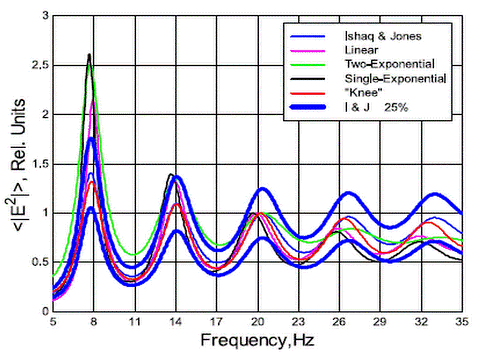
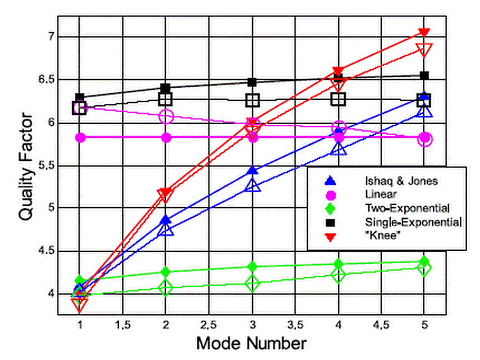
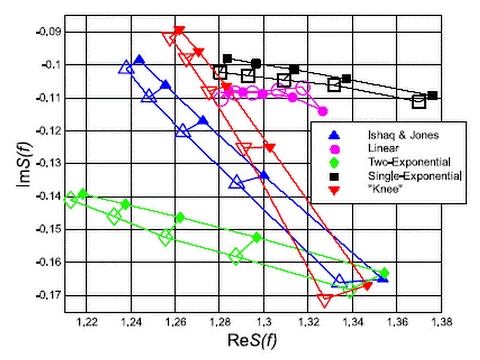
References
Mushtak, V.C. and E.R. Williams, ELF propagation parameters for uniform models of the Earth-ionosphere waveguide, J. Atmos. Sol. Terr. Phys., 64, 1989, 2002.
Williams, E., V. Mushtak and A. Nickolaenko, Distinguishing ionospheric models using Schumann resonance spectra, J. Geophys. Res., 111, D16107, doi:10.1029/2005JD006944, 2006.
(9) Can Severe Storms with Inverted Electrical Polarity be Explained by Extreme Thermodynamic Conditions?
The vast majority of thunderstorms worldwide are grossly characterized by positive dipoles, with positive charge at upper levels and negative charge at mid-levels. Recent observations in the western Great Plains of the U.S. have disclosed a special subset of thunderstorms whose gross electrical polarity is opposite and are therefore characterized as 'inverted polarity'. Multiple laboratory simulations of ice particle charging indicate that inverted polarity thunderstorms may be caused by extraordinary liquid water contents in the mixed phase region (Williams et al, 1991). Thermodynamic observations over the U.S. are considered that may promote large liquid water content aloft. The simultaneous presence of high cloud base height and large Convective Available Potential Energy(CAPE) has been identified as key thermodynamic conditions for the anomalous storms.
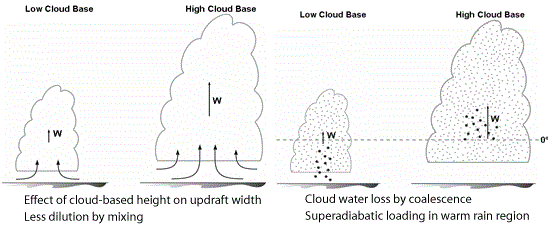
References
Krehbiel, P.R, R.J. Thomas, W. Rison, T. Hamlin, J. Hamlin, and M. Davis, GPS-based mapping system reveals lightning inside storms, EOS, Trans. Amer. Geophys. Union, 81, 21, 2000.
Lang, T. J., L.J. Miller, M. Weisman, S.A. Rutledge, L.J. Barker, V.N. Bringi, V. Chandrasekar, A. Detwiler, N. Doesken. J. Helsdon, C. Knight, P. Krehbiel, W. Lyons, D. MacGorman, E. Rasmussen, W. Rison, W.D. Rust, and R.J. Thomas,. The Severe Thunderstorm Electrification and Precipitation Study, Bull. Amer. Met. Soc., 85: 1107-1125, 2004.
Rust, W.D. and D.R. MacGorman, Possibly inverted-polarity electrical structures in thunderstorms during STEPS, Geophys. Res. Lett., 29, No. 12, 10.1029/2001GL014303, 2002.
Williams, E.R., R. Zhang and J. Rydock, Mixed-phase microphysics and cloud electrification, 48, 2195-2203, 1991.
Williams, E., V. Mushtak, D. Rosenfeld, S. Goodman and D. Boccippio, Thermodynamic conditions favorable to superlative thunderstorm updraft, mixed phase microphysics and lightning flash rate, Atmos. Res., 76, 288-306, 2005.
(10) Why is Lightning More Prevalent in the Congo River Basin in Africa than in the Amazon basin in South America?
The two most prominent tropical continental 'chimneys' are found over Africa and South America. The lightning activity in Africa is more than twice that in South America. Suggested explanations for this difference are based on subtle thermodynamic contrasts and on atmospheric aerosol. Williams and Satori (2004) attribute the bulk of the lightning contrast to the observation that the Congo is slightly hotter and slightly drier than the Amazon. The role of aerosol was studied earlier (Williams et al, 2002).

References
Williams, E.R., and Coauthors, Contrasting convective regimes over the Amazon: Implications for cloud electrification, J. Geophys. Res., LBA Special Issue, 107, D20, 8082, doi:10.1029/2001JD000380, 2002.
Williams, E.R. and G. Satori, Lightning, thermodynamic and hydrological comparison of the two tropical continental chimneys, Journal of Atmospheric and Solar Terrestrial Physics, 66, 1213-1231, 2004.
(11) Is Dust from Africa the Main Contributor to Surface Sediment in the Amazon Basin of South America?
The export of mineral dust out of the arid region of Africa and across the Atlantic Ocean is well documented. The Bodélé Depression southeast of Faya Largeau in Chad is recognized as an important dust source in Africa. During boreal winter, Bodélé dust has been shown to reach the Amazon Basin. The predominant surface sediment in the Amazon is the belterra clay, and covers more than 106 km2 in a layer 1-5 meters thick.
To test the idea that the belterra clay had its origin in dust from the Bodélé Depression, samples of dry lake bed sediment were collected in Chad in September 2010, along with samples of airborne dust. Samples of belterra clay from the Brazilian states of Amazonas and Para were also collected in November 2010. Pb isotope analysis of the sample pairs (by Max Planck investigators) has shown that the predominant surface sediment in the Amazon Basin has origin in local erosion and cannot have origin in Africa.

References
Abouchami, W., K. Näthe; A. Kumar; S. Galer; K. P. Jochum; E. Williams; A. Horbe; J. Rosa; W. Balsam; D. Adams; K. Mezger and M. O Andreae, Geochemical and isotopic characterization of the Bodélé Depression dust source and implications for transatlantic dust transport to the Amazon Basin, Earth and Planetary Science Letters, 15, 112–123, 2013.
Koren, I., Kaufman, Y.J., Washington, R., Todd, M.C., Rudich, Y., Martins, J.V., Rosenfeld, D., The Bodélé depression: a single spot in the Sahara that provides most of the mineral dust to the Amazon forest. Env. Res. Lett. 1, 1-5, 2006.
Sombroek, W.G., Amazon soils: A reconnaissance of the soils of the Brazilian Amazon region, Centre for Agricultural Publications and Documentation, PUDOC, Wageningen, 1966, 302 pp.
(12) What are the Trends in Global Lightning and Surface/Tropospheric Air Temperature over the Last Decade?
The relationship between the global temperature and global lightning activity has been a topic of interest for more than twenty years (Williams, 1992). The global surface air temperature showed a dramatic increase over the period 1976 to 2000, but the record from 2000 to present is statistically flat. The best record of global lightning activity over the recent decade is that from the Lightning Imaging Sensor (LIS) on board the NASA TRMM satellite, whose optical response has been shown to be stable for the same period. The monthly flash rate on LIS over the last decade is also statistically flat (Williams, 2012). The pronounced annual variation in global temperature and global lightning are the most conspicuous signals in the decadal records.

References
Williams, E.R., The Schumann resonance: A global tropical thermometer, Science, 256, 1184-1187, 1992.
Williams, E.R., 2012. Franklin Lecture: Lightning and Climate
(http://fallmeeting.agu.org/2012/events/franklin-lecture-ae31a-lightning-and-climate-video-on-demand/)
(13) Can standard Surface Meteorological Observations be used to Predict the Onset of Urban Malaria in Niger?
Clinic reports on malaria incidence with daily resolution over the urban area of Niamey, Niger show abrupt increases that are essentially synchronous across the city, but with an onset that varies from wet season to wet season. Meteorological factors were examined in attempts to explain this abrupt onset. Standing water is essential for the development of mosquito larvae. As the wet season comes on, rainfall episodes begin. Initially, the accumulated rainfall evaporates from the surface in a few hours or less. But with each rainfall episode, the relative humidity of boundary layer air increases. Eventually, a single rainfall event occurs that saturates the ground and guarantees the presence of standing water over a large area. (The rainfall events in West Africa are typically mesoscale convective systems that affect a large areas of 104 km2 or more.) Empirically, the persistent standing water condition is simultaneously achieved when the relative humidity at night reaches a plateau of 80%. Curiously, this is the typical value for relative humidity in the boundary layer over tropical oceans, suggesting that nocturnal land areas with standing water are resembling an ocean.
Consistent time lags have been documented between the onset of standing water, the explosion of mosquito populations and the onset of malaria cases in the clinics. These findings may find value in organized efforts to combat mosquitoes with insecticides, or to staff clinics for the medical care of the infected population.
References
Hydrometeorological, Entomological and Epidemiological Time Markers for Urban Malaria in Niamey, Niger, Williams, E.R., American Geophysical Union Fall Meeting, 2010
Click here to download the Microsoft Powerpoint presentation
(14) Is Hurricane Activity in the Atlantic Ocean Linked with Drought in the Upper Amazon Basin?
The height of the Amazon river has been recorded continuously for more than a century in Manaus Harbor, near the confluence of the Rio Negro and Rio Solimoes. This river stage serves as a giant raingage for the upper half of the Amazon basin. By far the lowest wet season river level was recorded in 1926 (Williams et al., 2005), and this year may well have been the driest season in the Amazon during the 20th century. It was noticed that this year was also the second most frequent hurricane season in the Atlantic in the analysis of Gray (1984). The regression of the Manaus annual low water mark against the seasonal number of hurricanes showed a significant negative correlation. The physical interpretation of these findings is that enhanced upwelling in the local Hadley circulation during an active hurricane season in the equatorial Atlantic Ocean is linked with enhanced subsidence over the western Amazon basin, and hence reduced rainfall and lower river gage height at Manaus.
References
Severe Amazon Droughts and Teleconnections to Atlantic Hurricanes, Williams, E.R., Brazil-MIT Summit, 2010
Click here to download the Microsoft Powerpoint presentation
Gray, W.M., Atlantic seasonal hurricane frequency. Part I: El Nino and 30-mb quasi-biennial oscillation influences. Mon Wea. Rev. 112, 1649-1668, 1984.
Williams, E.R., A. Dall' Antonia, V. Dall' Antonia, J. Mathias de Almeida and F. Suarez The drought of the century in the Amazon basin: An analysis of the regional variation of rainfall in South America in 1926, Acta Amazonica, 35(2), LBA Special Issue, 2005.
(15) What Cloud Microphysical Conditions are Associated with Hexagonal Flat Plate Crystals in Snowstorm?
The entire NEXRAD network of S-band radars has been recently equipped with dual pol capability, thereby enabling the identification of hydrometeor shapes that opens up a new avenue into cloud microphysics, and a new tool to assess conditions linked with supercooled water and icing hazard to aircraft. The Convair-580 research aircraft operated by the National Research Council of Canada has been used in collaboration with MIT Lincoln Laboratory to validate hydrometeor types and possible riming conditions in East Coast snowstorms also documented with NEXRAD dual pol radars. In a flight on February 28, 2013, the aircraft was directed to a region characterized by differential reflectivity values exceeding +8 dB. The aircraft encountered there a predominance of hexagonal flat plate crystals oriented primarily horizontally by gravity, and in the presence of intermittent supercooled water with concentrations in the range of 0.05-0.1 g/m3. Some evidence for riming was noted. These observations are consistent with the diffusion chamber crystal habit diagram of Bailey and Hallett (2009) showing evidence for hexagonal flat plate crystals both above and below the boundary of water saturation.
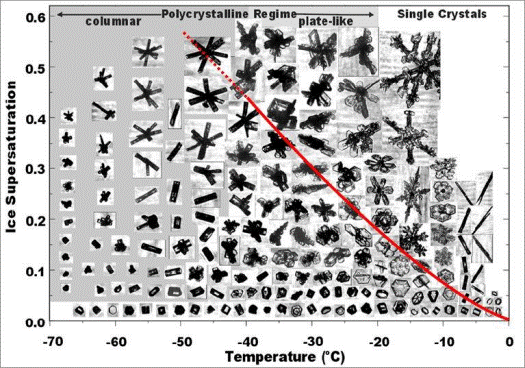
References
Bailey, M. P. and J. Hallett, A comprehensive habit diagram for atmospheric ice crystals: Confirmation from the laboratory, AIRS II, and Other Field Studies. J. Atmos. Sci., 66, 2888-2899. doi: http://dx.doi.org/10.1175/2009JAS2883.1 , 2009.
Williams, E.R., D. J. Smalley, M. F. Donovan, R. G. Hallowell, K. T. Hood, B. J. Bennett, R. Evaristo, A. Stepanek, T. Bals-Elsholz, J. Cobb, and J. Ritzman, Dual Polarization Radar Winter Storm Studies Supporting Development of NEXRAD-based Aviation Hazard, AMS Radar Conference, Pittsburgh, PA., September, 2011.
Williams, E.R., D. J. Smalley, M. F. Donovan, R. G. Hallowell, K. T. Hood, B. J. Bennett, R. Evaristo, Validation of NEXRAD Radar Differential Reflectivity in Snowstorms with Airborne Microphysical Measurements: Evidence for Hexagonal Flat Plate Crystals, 36th Conference on Radar Meteorology, Breckenridge, CO., 16-20 September, 2013.
(16) Can Consideration of the Conservation of Vector Angular Momentum be Helpful in Understanding the Problem of Tornadogenesis?
The physical mechanism of tornadogenesis remains an unsolved problem. The Doppler radar observation of the mesocyclonic circulation preceding most tornadoes can be used to estimate the vertical angular momentum of that circulation. One such measure is the product of the maximum tangential wind speed of the mesocyclone and its radius. The documentation of this quantity in a height-time format sheds light on the transfer of angular momentum from mesocyclone to the tornado itself when it appears at ground level, whose much tighter circulation is often not accessible to the Doppler radar except at very close range. Examination of such time-height plots for a number of tornado cases ranging from F1 to F5 shows a prevalent tendency for pronounced maximum angular momentum aloft, in a range of altitude from 3 to 7 km, and then a marked diminishment aloft at the time of the tornado. These observations, together with the well-known law in physics that angular momentum is conserved, suggest that the reservoir of angular momentum aloft is descending to account for the tornado.
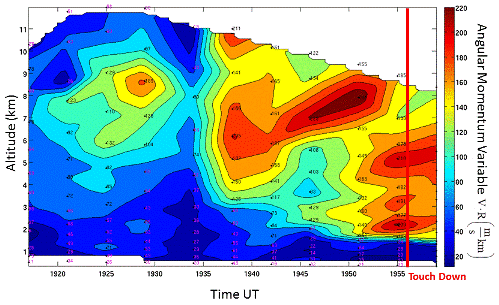
References
Williams, E.R. et al., Conservation of vertical angular momentum during tornadogenesis, 36th Conference on Radar Meteorology, Breckenridge, CO., 16-20 September, 2013. Conference on Radar Meteorology, Breckenridge, CO., 16-20 September, 2013.
(17) What are the Key Contributions of C.T.R. Wilson to the Present Understanding of the Electrical Structure of Thunderstorms and to the Energetic Particles they are Now Known to Produce?
One of the foremost contributors to the science of atmospheric electricity was the Scottish physicist C.T.R. Wilson. This scientist worked methodically between laboratory and field observations to pioneer many new concepts in this realm. His field observations in England established the dominant electrical polarity of thunderstorms, and with a long-standing gentlemanly debate with G.C. Simpson, the tripole structure was exposed. The observations of the glory on Ben Nevis (the highest point in the British Isles) led to the development of the cloud chamber, and the meticulous observations of the tracks of electrons therein led Wilson to propose the existence of runaway electrons and the production of energetic particles by electrified clouds.
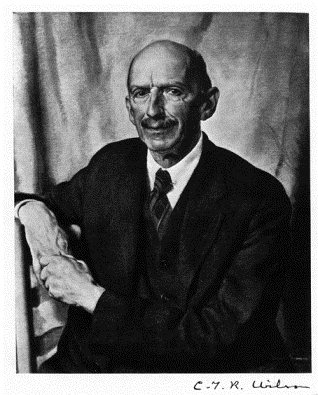
References
Williams, E.R., C.T.R. Wilson versus G.C. Simpson: Fifty years of controversy in atmospheric electricity, Atmos. Res., 91, 259-271, 2009.
Williams E.R., Origin and context of C.T.R. Wilson's ideas on electron runaway in thunderclouds, J. Geophys. Space Phys., DOI: 10.1029/2009JA014581, 4 Aug 2010.